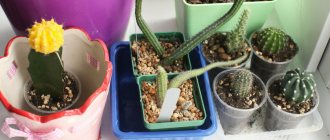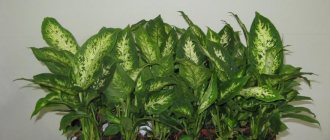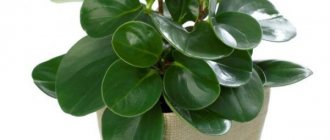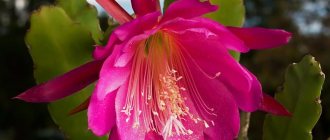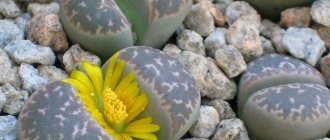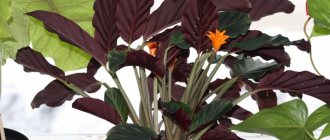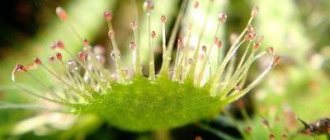Author: Elena N. https://floristics.info/ru/index.php?option=com_contact&view=contact&id=19 Category: Houseplants Published: June 21, 2017Last edits: January 11, 2021
- Growing from seeds
- Diseases and their treatment
- Veitch's pandanus, or Vicha (Pandanus veitchii)
- Is it possible to keep pandanus at home?
Pandan, or pandanus (lat. Pandanus) is a genus of tree-like plants of the Pandanaceae family, which includes about 750 species, growing mostly in the tropical climate of the Eastern Hemisphere. About 90 species of the genus grow on the island of Madagascar; pandanuses are found in Hawaii, along the coast of Western India, in the east of Northern India, in the lowlands of Nepal, in West Africa, Vietnam and from Australia to Polynesia. Pandanuses adapt to various conditions: they grow on the sea coast, along river banks, in swamps, as well as in mountain and alpine forests, on the slopes of volcanoes and on coral reefs.
Planting and caring for pandanus
- Flowering: the plant is grown as an ornamental foliage plant.
- Lighting: in autumn and winter - bright diffused light, in summer and spring - light partial shade: eastern and western window sills are most suitable for the plant.
- Temperature: all year round – 19-25 ˚C. The lower temperature limit is 12 ˚C.
- Watering: in summer - regular and abundant, as the top layer of the substrate in the pot dries. In autumn and winter – moderate and not so frequent.
- Humidity: normal. It is not recommended to wash or spray the leaves. In conditions where the air is too dry, the pandanus is placed on a tray with wet expanded clay.
- Feeding: from March to August - 2 times a month with a solution of complex mineral fertilizer for decorative deciduous plants. During the rest of the year, no fertilizing is applied.
- Rest period: not clearly expressed.
- Replanting: young plants - annually, from the age of three - only if necessary, when the roots become cramped in the pot. This usually happens once every 2-3 years. Pandanus is transplanted using the transshipment method.
- Reproduction: by cuttings, dividing the bush, sometimes by seeds.
- Pests: scale insects, false scale insects, mealybugs, spider mites.
- Diseases: root rot.
Read more about growing pandanus below.
Fertilizers for plants
For normal growth and health of the plant, it is necessary to fertilize the soil:
- in spring and summer – 2 times/month;
- the rest of the time, no feeding is required;
- for a transplanted plant - no earlier than 1 month after moving.
Mineral mixtures
The unpretentiousness of pandanus allows you to use any universal mineral fertilizers for deciduous and ornamental plants in liquid form for feeding. When purchasing a complex mineral fertilizer, you need to pay attention to the content of the main components in it: nitrogen, phosphorus, potassium (abbreviation NPK).
Taking into account the ratio of these components assumes (examples):
- 11-6-9 (predominance of nitrogen necessary for the development of the mass of a young plant);
- 7-9-13 (increased content of phosphorus and potassium for feeding during the flowering period);
- 13-15-18 (universal fertilizer balanced in composition for wide use).
Gardeners recommend paying attention when purchasing to the absence of nitrates and chlorine in the fertilizer.
Organic fertilizers
As a fertilizer of organic origin, gardeners recommend using solutions:
- sifted wood ash (3 tbsp/l);
- granulated bird droppings (1 tsp/l);
- rotted manure (compost) (1 tbsp/l).
You need to add organic matter for fertilizing carefully, having first disinfected it (for natural types of fertilizer). Organic ingredients purchased in stores should be used according to the instructions (for example, “Gumisol”, “Vermistim”). Gardeners recommend adding a small amount of organic matter and ash to the soil mixture when replanting pandanus. The use of organic fertilizers is associated with the appearance of an unpleasant odor after application.
Botanical description
Pandanuses are tree-like evergreens, sometimes shrubs, reaching a height of 10-15 and sometimes 25 m in natural conditions. Externally, these plants look like vines or palm trees. Pandanus often form aerial roots, which eventually grow into the soil. With age, the lower part of the trunk of pandanus dies, and the plant is kept in an upright position precisely due to the aerial roots that have grown into the soil and become lignified, which are called stilts.
The leaves of pandanus are linear, xiphoid, slightly grooved, sharply serrated at the edges, up to 4 m long and up to 15 cm wide. They are located on the trunk in two spiral rows, which is why pandanus is called a screw tree or a screw palm. With age, the lower leaves fall off and scars remain in their place. The flowers of the plant are small, yellow, unisexual, without a perianth, collected in panicles or on cobs; however, pandanuses bloom infrequently in cultivation.
The screw palm is an unpretentious plant for spacious halls and winter gardens, which easily tolerates a lack of light and moisture, grows quickly, but requires a lot of space, so only young pandanuses can be kept in an apartment.
- Photo of indoor jatropha + description
Rules for pruning plants
Pandanus does not need pruning; the lower leaves die off naturally. To improve appearance, it is allowed to trim off the yellow ends of injured leaves without touching healthy tissue.
It is strictly forbidden to cut off the plant's aerial roots, which help the pandanus to maintain reliable stability in the pot.
Caring for pandanus at home
Growing conditions
The pandanus plant prefers bright light in autumn and winter and light shade in spring and summer. The best place for it would be the window sills oriented east or west. Indoor pandanus cannot put up with a lack of light for long: very soon the leaves of the pandanus, losing strength, begin to bend, and the variegated forms lose their original color. In case of insufficient lighting, it is necessary to install an additional light source for the pandanus at a distance of 60-70 cm, which should work for at least 8 hours a day. To prevent the plant from developing one-sidedly, it must always be turned to the light in different directions. In winter, rooms with home pandanus must be regularly ventilated, but the plant should be protected from drafts.
The pandanus flower feels good at normal room temperature - 19-25 ºС: it does not need any difference between summer and winter maintenance. The main thing is that the thermometer column does not fall below 12 ºС.
Pandanus prefers moderate air humidity. If the air in the room is dry, place the flowerpot with the plant on a tray with damp pebbles or expanded clay. It is not recommended to spray or wash pandanus, because water can get into the axils of the leaves, and this causes rotting of the stem. The leaves of the plant are wiped from dust with a damp cloth or washcloth from the base to the top, and it is better to carry out this procedure with gloves: pandanus leaves are equipped with thorns.
In indoor conditions, the plant rarely forms aerial roots, but if they appear, do not try to remove them, it is better to cover them with damp moss so that they do not dry out, and keep the moss moist all the time. This is especially important in the summer. If pandanus does not form aerial roots at home, it will lose stability over time.
Watering
In summer, the pandanus palm tree needs plenty of moisture, but the top layer of the substrate should dry out between waterings. However, the entire earthen pandanus plant should not be allowed to dry out. Water the plant with water heated to 35 ºС, and half an hour after moistening, you need to drain the excess water from the pan. Pandanus should be watered 2-3 days after the top layer of soil in the pot dries out. In autumn and winter, watering pandanus is reduced. Water for irrigation should be settled and not cold.
Top dressing
During the spring-summer period (from March to August), pandanus is fed every two weeks with a solution of complex mineral fertilizer for decorative foliage plants. In autumn and winter, pandanus does not need feeding.
- Conditions for growing kiwi in our apartments
Transfer
Pandanuses are replanted only when its roots have mastered the entire earthen ball: young plants annually, adults - once every 2-3 years. The roots of pandanus are very fragile, so transplantation is carried out using the transshipment method.
The substrate for pandanus is prepared from leaf and turf soil, sand and humus, mixing them in equal parts. The dishes need to be deep; one third of them are filled with drainage material. Before transplanting, pandanus leaves are lifted up and tied, then the plant is transferred to a new pot, after which the voids are filled with soil mixture. The pandanus in the new pot should remain at the same level at which it grew in the old one.
Transplantation without the risk of injury. Step-by-step instruction
The palm tree needs to be replanted in the spring.
The sequence of transplanting pandanus into a new container is as follows:
- First you need to prepare a spacious, tall container, the bottom of which should be filled with a drainage layer of pebbles to 1/3 of the height of the pot.
- Prepare a new soil mixture to add after moving the plant.
- Then carefully collect the pandanus leaves at the top and secure them in this position with a wide ribbon.
- Considering the significant fragility of the pandanus root system, you need to tilt the old pot, holding the pandanus by the base, carefully remove the plant with a lump of earth and move it to a new container, in which the planting level should not be lower than in the old pot.
- Fill the empty spaces in the pot with new soil, compacting it slightly.
- Untie the foliage of the pandanus, check the stability of the plant and the verticality of its trunk.
An adult pandanus, if it is significant in size, does not need to be replanted if its tub has a suitable volume. In this case, you need to replace the top layer of soil with a new mixture to a depth of up to 1/3 of the height of the tub.
Pandanus propagation
Pandanus propagates by seeds, cuttings and dividing the bush.
Growing from seeds
Immediately after collection, the seeds in fruit clusters are sown in a mixture of sand and peat or sand and leaf soil in equal proportions and covered with film or glass. Keep crops at a temperature not lower than 25 ºС, regularly ventilating and moistening the surface of the substrate. Shoots appear in groups after 2-4 weeks, but if you use a mini-greenhouse with bottom heating to germinate seeds, the seeds will germinate earlier. When the seedlings develop 2-3 true leaves, they are planted in separate pots with a mixture of turf soil, sand and leaf soil in equal proportions.
Cuttings
Pandanus cuttings are harvested from side shoots: their length should be at least 20 cm, since short shoots do not form roots well. The cut areas are sprinkled with charcoal and dried, and then the cuttings are planted in a substrate of peat and sand (1:1), covered with a glass cap or a transparent bag and kept at a temperature of 25-28 ºС, regularly ventilating and moistening the soil with a sprayer. Rooting of cuttings lasts 1.5-2 months, but when using a root formation stimulator and a mini-greenhouse, the process will go faster.
Dividing the bush
At the base of the trunk of an adult pandanus and in the axils of its leaves, daughter rosettes are formed in large numbers. They are separated from the mother plant when they reach a length of 20 cm and acquire their own roots. In order for these roots to appear, you need to cover the bases of the children with sphagnum, moistening it with a spray bottle as it dries.
The cut rosettes are dried for 24 hours. A layer of drainage material 1.5-2 cm thick is placed in a flat dish, then a layer of turf soil 6-7 cm thick, and a layer of washed sand 3-4 cm thick is placed on top of it. The roots of the rosette are buried 2 cm in the sand and pressed tightly. around the baby, spray with water from a spray bottle and cover the outlet with a glass cap or a transparent plastic bag. For successful rooting, the soil temperature must be at least 22 ºС. Rooting occurs in a month and a half. To speed up the process, phytohormones can be used. After two months, the rosettes, together with a lump of earth, are transplanted into a large container filled with a mixture of turf, leaf soil and sand in a ratio of 2:3:1.
- Photo of two-color arrowroot
Watering
It is important to be careful when watering the flower so that water does not get into the axils of the leaves, as this may cause the plant to rot. Therefore, there is no need to spray the flower
Dust from the leaves is carefully removed using a slightly moistened cloth or a special broom.
To keep the air from drying out, you can spray it a little from a small spray bottle or place the flowerpot in a bowl with damp expanded clay or sphagnum. In the warm season, the plant should be well watered. In cool weather, watering will be less abundant, except in a hot room. In particular, you need to gradually reduce the amount of watering with the beginning of autumn days
It is also important to ensure that the water does not sit in the pan for a very long time. If you water pandanus in a tray, then after half an hour you need to remove excess water
It is best to collect a certain amount of moss, which covers additional rhizomes (lateral, stilted) and then moisten this moss a little - this creates an additional layer and optimal moisture, and for leaves the best thing is to wipe with damp gloves, which you put on your hands, moisten and wipe consistently plant.
Diseases and pests
Diseases and their treatment
Pandanus at home is very rarely affected by pests, but sometimes scale insects, scale insects and spider mites can be found on it.
Scale insects form brown scaly formations on the leaves of the plant and leave a sticky discharge. These pests are destroyed by treating pandanus with Actellik and Karbofos.
Mealybugs are removed with a cotton swab or brush soaked in alcohol, after which the plant is treated with an anticoccidal drug, for example, Tolkox, Diclox or Coccygard.
Spider mites appear on the plant in conditions of low air humidity: dots (punctures) appear on the leaves, merging with each other. It is necessary to treat the pandanus with an acaricide (Aktellik, Aktara) and increase the air humidity by placing the plant on a tray with wet expanded clay.
Why does pandanus turn yellow?
The plant is resistant to diseases, but sometimes pandanus leaves turn yellow. Why does this happen? Most often, this phenomenon is caused by excess light, watering with hard water or high calcium content in the soil.
Due to insufficient lighting, pandanus leaves become smaller, and variegated forms lose their original colors.
Low air humidity causes the tips of pandanus to dry out and turn brown, but if you keep the plant on a tray with wet pebbles, this can be avoided.
Possible difficulties during cultivation
Improper agricultural practices often affect the external condition of the palm tree. Therefore, timely measures and prevention of common mistakes can save your palm tree from common problems.
Important! Dry lower leaves of a palm tree are a natural process of its development. But if it scares you with its abundance, add nutrients to the soil and replant the plant in the spring. A similar picture can also be observed when the plant is exposed to a draft
You can save the situation by spraying water from a spray bottle near the plant. Experienced housewives advise, as a preventive measure, to place the pot in a tray with damp expanded clay or forest moss, and also never open windows or balcony doors near the flower.
A similar picture can also be observed when the plant is exposed to a draft. You can save the situation by spraying water from a spray bottle near the plant. Experienced housewives advise, as a preventative measure, to place the pot in a tray with damp expanded clay or forest moss, and also never open windows or balcony doors near the flower.
This nuance is very important, since a lack of moisture is just as dangerous for pandanus as its excess. When water stagnates in the pot, favorable conditions are formed for the development of root rot. This problem can only be prevented by proper watering. In cases where the disease has already progressed, an urgent transplant will be required to remove all damaged parts of the root.
Important! You cannot cut off the aerial roots of pandanus - they supply the plant with moisture and provide additional support for the heavily overgrown palm-shaped cap.
Pandanus that lived in the garden in the summer can be affected by scale insects. You can notice parasites on the underside of the leaf along the central vein. If there are only a few insects, try collecting them by hand. Otherwise, you will need to spray with an insecticide (Aktara, Bi-58, Konfidor).
Learn about the propagation features of violets, streptocarpus, orchids, zamioculcas, dieffenbachia, cactus, shefflera, and laurel.
Types and varieties
Veitch's pandanus, or Vicha (Pandanus veitchii)
An evergreen tree-like plant native to Southeast Asia with a shortened trunk and aerial supporting roots extending from it. Green leaves with a white bordering stripe, up to 1 m long and 5-8 cm wide, are arranged spirally, their edges are lined with light spines with white tips. In culture, under favorable conditions, Veitch's pandanus can grow up to one and a half meters in ten years. The species has a variegated variegated form. At home, Veitch's pandanus blooms very rarely.
Pandanus utilis
It is a large plant, reaching a height of 20 m in natural conditions, but in cultivation it grows only up to 2-3 m. In addition, the useful pandanus, which branches after flowering, does not bloom in indoor culture, and therefore does not branch. The dark green hard leaves, densely dotted along the edges with reddish thorns, are spirally arranged along the trunk, reaching a length of 1-1.5 m and a width of 5-10 cm.
Pandanus sanderi
Grows in tropical rainforests of the Malay Archipelago. This is a plant with a short trunk and dark green leaves with narrow yellow longitudinal stripes and a small number of thorns along the edges. The leaves are about 80 long and up to 5 cm wide.
Pandanus tectorius
An evergreen branched shrub with stilted roots, reaching 3-4 m in height in natural conditions. The leaves of plants of this species are linear, strongly tapering towards the ends, on which there are narrow white spines. In nature, pandanus planta produces sweet, tasty fruits that are yellow, red, or orange in color. A variety of laevis is often found with leaves two meters long without thorns and white or pinkish flowers with a diameter of 5-10 cm. In cultivation, this type of fruit does not form, and it blooms extremely rarely.
Interesting features
The plant is unique in that throughout its life it forms aerial roots in the lower part of the trunk, which grow and take root in the ground over time. These roots, which can also be called stilt roots, help the plant maintain balance and stability when it reaches a large size. If a plant lives in the wild, at a certain period the lower part of its trunk dies and it survives only thanks to these additional roots.
But you should not hope that caring for the pandanus plant at home will allow it to grow in this way. The plant is unlikely to root its stilted roots so firmly in the ground. This is only possible in nature, but does not mean that these additions need to be removed. The plant needs aerial roots, so they need to be strengthened and moistened. But in order for the grown, huge pandanus to stand firmly, it needs to be supported with special devices; it will not stand on its own.
In spacious natural conditions it produces flowers and bears fruit. Some of their species are even edible. They look like a pineapple. These fruits feed on crabs, which carry out the mission of distributing seeds. But if the plant lives in the house, it will neither bloom nor bear fruit. Although you should not be discouraged in this regard, and also give up hope, since there are still some probabilities, you will need to study the relevant literature and create optimal conditions, and you may also need to make an appropriate graft from a fruit-bearing plant.
- useful (P. utilis), the leaves of which reach 10 cm wide, have a dark green color, monochromatic;
- Sander (P. sanderi) - leaves are twice as narrow as the previous type - up to 5 cm, but with long white stripes;
- Veitch (P. veitchii) - its leaves are distinguished by yellow stripes on the edges.
Signs
Is it possible to keep pandanus at home?
Despite the well-deserved popularity of pandanus, sometimes readers of our site ask whether it is possible to keep it in an apartment. Rumor has it that it absorbs positive emotions and transforms them into aggressive energy, which negatively affects unbalanced people, making them angry and overactive. What's the answer here? If you are impressionable and have a hard time withstanding troubles, you may experience discomfort near the pandanus. In this case, it is better for you not to keep the plant either at home or at work. And for people with a strong nervous system, novice gardeners and those who often go on business trips, pandanus is an ideal plant: it is beautiful, unpretentious, does not require frequent watering and grows quickly.
Benefits or harms of pandanus
While it is almost impossible to see exotic flowers blooming at home, in nature the plant blooms very beautifully. During this period, the tree is decorated with spikelets of numerous small inflorescences. The flowers do not have perianths, but have covering leaves.
The plant is unisexual. Therefore, male flowers appear on one bush. They resemble elongated spikelets. On the female, the inflorescences are shaped like corn cobs. The flowering of exotic flowers is accompanied by a subtle, pleasant fruity aroma.
The fruit resembles a pineapple. As it grows, it becomes clear that the fruit has its own characteristics and only vaguely resembles a pineapple.
It is difficult to collect fruit from the infructescence. They can be compared to very large kernels of corn.
Residents of the Pacific Islands and Papua New Guinea cannot imagine their diet without pandanus fruits. Pandan fruit provides people with vitamins, gives them a boost of energy and satiation. Fruits are boiled, cooked over a fire or eaten fresh. It is noteworthy that not only the fruits of the plant are edible, but also the lower parts of the foliage and inflorescences.
Pandan fruit
Some tourists believe that pandan is poisonous. This is wrong. The fruit is edible and not capable of causing harm. On the contrary, pandan is healthy.
For example:
- Seed oil tones the body and benefits the nervous system.
- The oil is used to relieve migraines and headaches.
- The leaves are suitable for healing wounds, abscesses, and skin diseases.
- The pulp from the leaves helps in the treatment of infectious diseases such as leprosy (leprosy), etc.
Pests can cause great damage to the screw palm. They lead to withering of the flower and deformation of the leaf plates.
The presence of cobwebs on the reverse side of the leaf blades is the main sign of spider mite damage. The characteristic white discharge on the leaves and trunk is the result of the activity of the mealybug. Pests are hiding under the round shields of a brown shade.
We suggest you familiarize yourself with Palm pollen benefits and harms
Why do the leaves turn yellow?
Pandanus is a very hardy plant. It is practically not damaged by diseases and pests. In exceptional cases, scale insects and false scale insects may appear on it, which can be removed with the help of Actellik. Treatments are repeated at intervals of 3 days, 2-4 sprayings are sufficient. Single pests are removed from the leaf with cotton wool soaked in vodka.
If the air is too dry, the tips of the leaves may dry out and turn brown. Despite its tropical origin, the palm tree does not need high air humidity, but in winter, when central heating is on, it will appreciate daily spraying - this will help protect the tips of the leaves from drying out.
The leaves turn yellow due to lack of nutrition. Like any fast-growing plant, pandanus needs high doses of fertilizer. Regular fertilizing in spring and summer and keeping the soil moderately moist will keep the leaves green and healthy throughout the year.
Variegated varieties lose their brightness, and new leaves grow small? This happens due to lack of light. In winter, it is better to move the plant to a south window. Due to excess light, the leaves become whitish. Also, leaves may turn white due to watering with hard water with a high calcium content.
Pandanus can safely be called the king of the winter garden. This is a great tapeworm. In the open air, the plant is transformed and looks luxurious and majestic. The screw palm never bends towards sunlight, even if the lighting is insufficient. It will always be slender and straight, only the foliage on the sunny side will be denser. The plant is kept in the room until about ten years of age, and then it is better to find more suitable conditions for it.
So, caring for pandanus is not difficult. The plants are unpretentious, hardy, and survive in darkened halls and vestibules, away from windows, in drafts. It is worth getting a pandanus if you need a fast-growing, unpretentious indoor flower that looks like a dracaena, yucca or palm tree.
Literature
- Grushvitsky I.V.
Order pandanaceae (Pandanales) // Plant life: In 6 vols. / Ch. ed. A. L. Takhtadzhyan. - M.: Education, 1982. - T. 6. Flowering plants. — P. 451—461. — 543 p. — 300,000 copies. - Pandanus // Plant life. Trees and shrubs. - M.: LLC "World of Books", 2003. - T. 7. - P. 152. - (Big Encyclopedia of Nature). — 15,000 copies. — ISBN 5-8405-0365-7.
- Pandan, generic name of plants // Encyclopedic Dictionary of Brockhaus and Efron: in 86 volumes (82 volumes and 4 additional). - St. Petersburg, 1890-1907.
- Pandan // Small Encyclopedic Dictionary of Brockhaus and Efron: in 4 volumes - St. Petersburg, 1907-1909.
- Pandanus // : / ch. ed. A. M. Prokhorov. — 3rd ed. - M.: Soviet Encyclopedia, 1969-1978.
